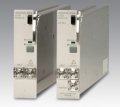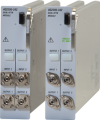You have 0 items in your cart.
The AQ2200-311A is a variable optical attenuation for the AQ2200 series. When it is installed in an AQ2200 series frame controller, it allows optical output to be attenuated to any value. Wide attenuation range: 0 to 60 dB (SM version) 0 to 45 dB (MM version) Wide wavelength range: 1200 to 1700 nm(SM version) 800 to 1370 nm (MM version) Low insertion loss: 1.0 dB (typical) Low polarization dependence loss: 0.1 dBp-p or less Monitor output (optional) Configure the desired measurement system by combining AQ2200 Series modules with Yokogawa optical communications measuring instruments
Compact: The AQ2200-331 features an optical variable attenuator and an optical power meter for monitoring the optical output power in a one-slot module. Ideal for bit error testing Compatible with SMF (core diameter of 10 µm) or MMF (core diameter of 62.5 µm) Attenuation accuracy: within ±0.1 dB With the output monitoring function, the AQ2200-331 allows direct setup of optical power at the output terminals Can be combined with various AQ2200 series modules or other Yokogawa's optical communication measuring instruments to build versatile measuring systems
Compact and space saving: The AQ2200-342 features two optical variable attenuator in a one-slot module Wavelength range: 1260 to 1640 nm Maximum attenuation range: 40 dB Fast attenuation control: 100 ms Shutter isolation: 70 dB or more Reduced energy, emission of CO2, NOX and SOX about 45% compared to the previous model.
Compact: Optical switches of 1 x 4 or 1 x 8 port configuration in a one-slot size module Compatible with SMF (core diameter of 10 µm) or MMF (core diameter of 62.5 µm) Low insertion loss: 1.0 dB (typ.) High switching reproducibility: within ±0.01 dB Can be combined with various AQ2200 series modules or other Yokogawa's optical communication measuring instruments to build versatile measuring systems DETAILS HIGH-PERFORMANCE OPTICAL SWITCH The AQ2200-411 OSW module is a space-saving optical switch featuring low insertion loss and superior switching reproducibility, and allows selection of 1 x 4 or 1 x 8 port configuration according to the application.Moreover, the optical fiber type can also be selected between SMF (core diameter of 10 µm) and MMF (core diameter of 62.5 µm), allowing a wide range of measuring systems to be built corresponding to the systems or devices used in optical public networks or optical LANs. EXAMPLES OF MEASUREMENT APPLICATION For measuring multiple objects, with switching of the object to be measured For measuring device characteristics, etc. by switching multiple measuring...
Compact: Optical switches of 1 x 16 port configuration in a two-slot size module Compatible with SMF (core diameter of 10 µm). MMF (core diameter of 50 or 62.5 µm) is also available on request. Low insertion loss: 1.0 dB (typ.) High switching reproducibility: within ±0.01 dB Can be combined with various AQ2200 series modules or other Yokogawa's optical communication measuring instruments to build versatile measuring systems
Compact: Optical switches of 1 x 2 or 2 x 2 port configuration in a one-slot size module Compatible with SMF (core diameter of 10 µm) or MMF (core diameter of 62.5 µm) Low insertion loss: 1.0 dB (typ.) High switching reproducibility: within ±0.01 dB Can be combined with various AQ2200 series modules or other Yokogawa's optical communication measuring instruments to build versatile measuring systems
The AQ2200-642 reduces the complexity and cost of 10G optical transceiver testing by combining bus and power control features into the same mainframe that performs Signal Generation, BERT and Optical testing. This allows a single programming interface to control all aspects of the transceiver test, simplifying test setup, decreasing test time and increasing productivity. The wiring complexity and test bench size are reduced by replacing separate Digital Multi-Meters, Programmable Power supplies and Serial I/F controllers with a single module.
The AQ2200-651 Signal Generator module reduces the complexity and cost of 10G optical transceiver testing by combining Signal Generation functions into the same mainframe that provides bus and power control while performing BERT and Optical testing. This allows a single programming interface to control all aspects of the transceiver test, simplifying test setup, decreasing test time and increasing productivity. The wiring complexity and test bench size are reduced by replacing up to 5 Signal Generators with a single module.













